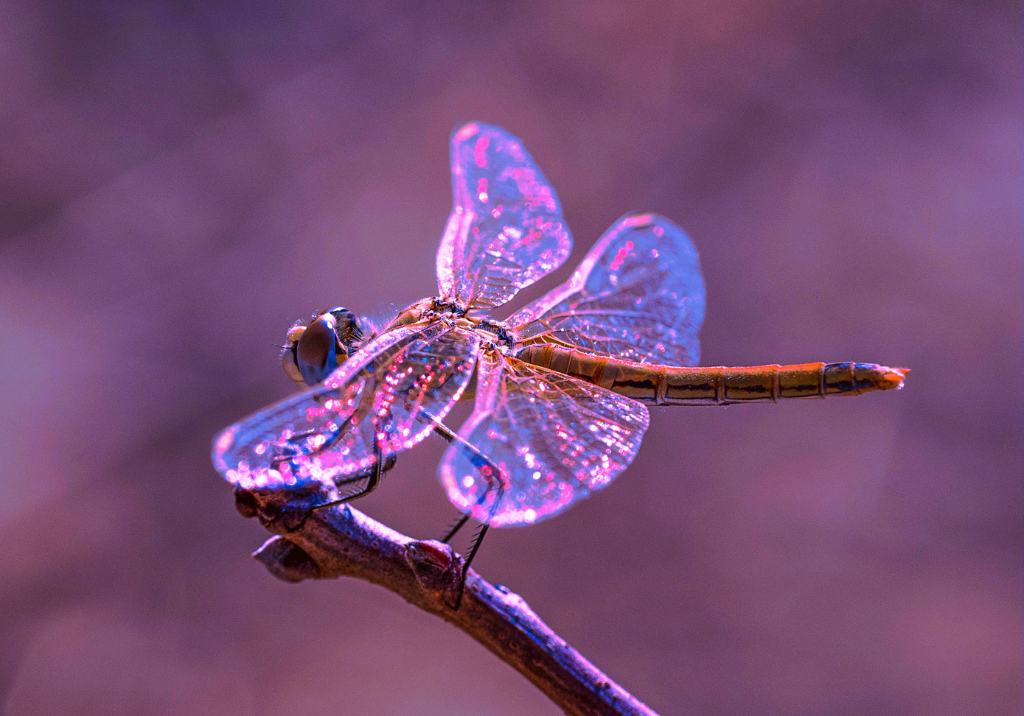Here is the meaning of dragonfly colors so you can learn more about these fascinating creatures.
Dragonfly colors carry rich symbolism. Furthermore, dragonflies generally symbolize change, transformation, joy, wisdom, and adaptability, but their coloration makes the dragonfly meaning more nuanced.
Dragonflies, once the largest insects, have over 300 million years of history.
Dragonfly symbolism varies from culture to culture, from change and transformation to happiness and good luck.
They come in many colors, featuring rich symbolism. But these colors are not just for aesthetic purposes; they also help them to camouflage themselves, attract mates or warn off predators.
In today’s article, you will find the answer to several questions, such as:
- What colors are dragonflies?
- What is the meaning of the dragonfly colors?
- What is their history?
- What do dragonflies symbolize?
The History of Dragonflies
The history of dragonflies dates back 300 million years. Just to put that into context, these guys were zooming around long before the dinosaurs even thought about making an appearance.
However, the size was different.
300 million years ago, dragonflies were the size of gulls. The reason behind this is related to the extra oxygen they benefited from in the atmosphere. [1]
Those dragonflies, part of the Meganeuridae family, were once the largest insects.
In recent times, dragonflies have gained a rich symbolism, which differs from culture to culture. For example, they symbolize courage, strength, and happiness in Japan. On the other side, the Navajo tribes in North America saw them as a symbol of pure water.
However, in most cultures, the dragonfly is associated with change, transformation, good luck, and adaptability.
In addition to their symbolism, they are also known for their amazing flying abilities. That’s because they can move in any direction, hover like a helicopter, and fly backwards.
But they also play a big role in controlling the populations of insects like mosquitoes and flies, which makes them pretty popular during the summer months.
Today, there are about 5,000 species of dragonflies, of which about 450 live in the United States.
What Do Dragonflies Mean?
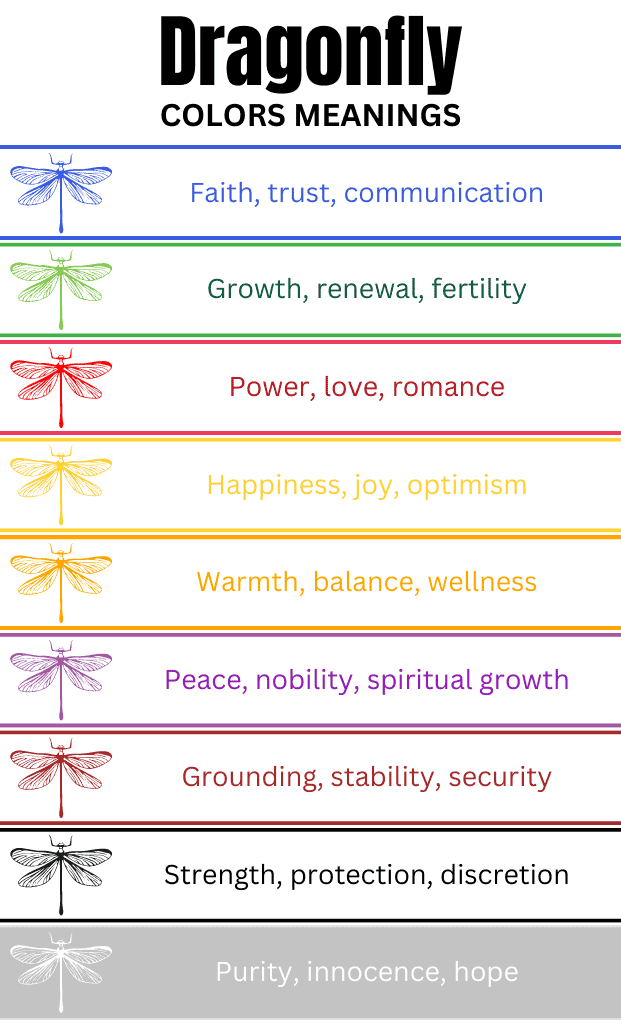
To use this free infographic, copy the code below. Otherwise, no rights will be granted.
<img src="https://thecolorsmeaning.com/wp-content/uploads/2023/07/dragonfly-colors-meaning-chart.png" alt="Dragonfly Colors Meanings" width="620px" border="0"><small>Source: <a href="https://thecolorsmeaning.com/meaning-of-dragonfly-colors/" rel="noopener" target="_blank">Dragonfly Colors Meanings</a> - thecolorsmeaning.com</small>Dragonflies are loaded with symbolism, and what they represent can vary depending on the culture or context.
Generally speaking, dragonflies are symbols of change and transformation. This makes a lot of sense when you think about their life cycle.
These creatures start as aquatic larvae (nymphs), living in water for up to several years. Then, they emerge and go through a dramatic metamorphosis to become the airborne beauties we recognize.
That’s why they’re often associated with adaptability, spiritual growth, and the deeper meaning of life.
Dragonflies can also symbolize our ability to overcome times of hardship and rise above and reach our true potential. They remind us to bring a bit of lightness and joy into our lives, even when things seem dark.
And let’s not forget their water connection as they begin their life in it. They can symbolize the emotional realm, our ability to navigate through our feelings, and the changes we might experience emotionally.
Dragonflies versus Damselflies
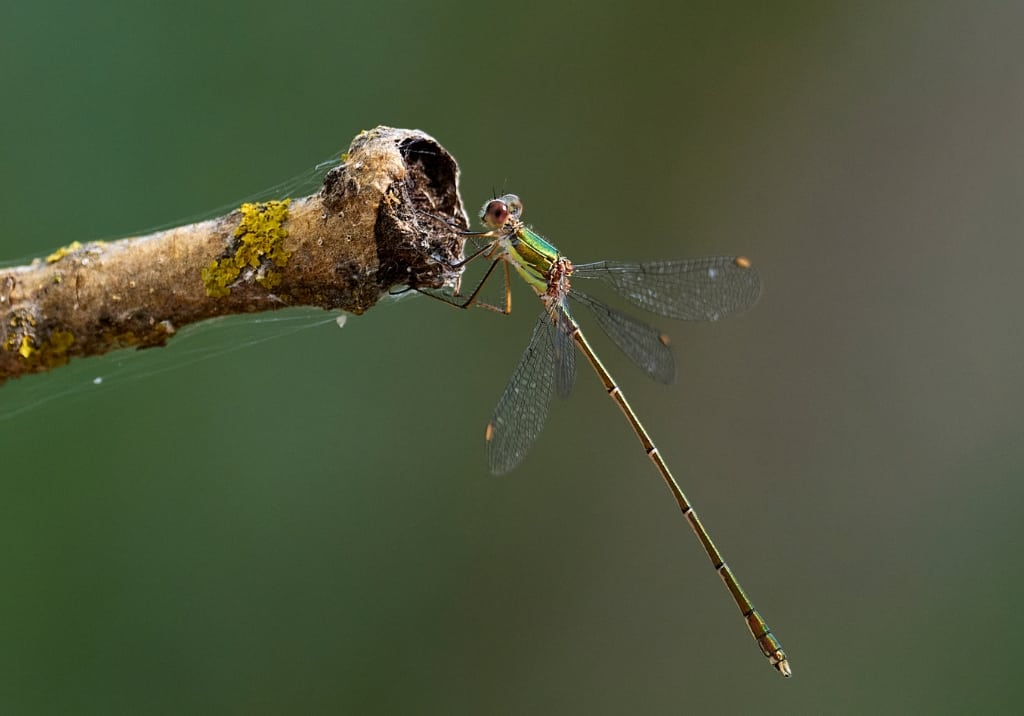
They’re both part of the same family (Odonata), but some key differences can help you tell them apart.
Dragonflies are typically more robust, with wider bodies, while damselflies are more on the slender side.
Furthermore, dragonflies rest with their wings horizontally spread, whereas damselflies rest with their wings closed over their bodies or slightly spread.
Unlike damselflies, which have eyes that are clearly separated, dragonflies have large, bulging eyes that are very close together.
In addition, dragonflies use their mouths to catch prey, whereas damselflies use their legs.
Regarding flight, dragonflies are like the fighter jets of the insect world. They’re powerful fliers, able to dart here and there, even backwards. Damselflies, on the other hand, are weaker fliers, and their flight is more fluttery.
Type of Dragonfly Colors
Dragonflies have two main types of colors: natural pigmentation and structural colors. Interesting that most have a bit of each.
Natural Pigmentation
Natural pigmentation is what we call natural colors in dragonflies. This is the color that comes from various pigments that the dragonflies produce.
The natural colors of dragonflies include brown, red, and orange.
Just like humans have different hair or eye colors, dragonflies can produce different pigments that give them unique coloration.
Structural Colors
Structural coloration comes from the physical structure of the dragonfly’s body and wings.
It’s not about pigments but about how the microscopic structure of their surface can absorb, reflect, or refract light to create different colors.
This can result in iridescent or metallic colors that can change depending on the angle of light. For example, green!
You know those dragonflies that seem to shift color when they move or that have a shiny, almost glowing look? That’s structural coloration.
Colors of Dragonflies
- Blue: The Blue Dasher (Pachydiplax longipennis) and the Common Hawker (Aeshna juncea).
- Green: The Giant Hawaiian Dragonfly is the most popular. However, green dragonflies are often found in areas rich in vegetation, such as the Eastern Pondhawk (Erythemis simplicicollis) and the Green Darner (Anax junius).
- Red: The Scarlet Darter (Crocothemis erythraea) and the Red-veined Darter (Sympetrum fonscolombii) are the most popular red dragonflies.
- Yellow: Yellow dragonflies are rarer than their blue and green counterparts. Some examples include the Yellow-sided Skimmer (Libellula flavida) and the Golden-winged Skimmer (Libellula auripennis).
- Black: The Black Petaltail (Tanypteryx hageni), the Black-tailed Skimmer (Orthetrum cancellatum) and the Black Darter (Sympetrum danae).
- White: White dragonflies are relatively rare. The White-faced Meadowhawk (Sympetrum obtrusum) and the White Corporal (Ladona exusta) are some white dragonflies.
- Brown: Brown is the most common butterfly color. Examples of brown butterflies include the Brown Hawker (Aeshna grandis) and the Stripe-winged Baskettail (Epitheca costalis).
- Gray: The Gray Sanddragon (Progomphus borealis), the Common Sanddragon (Progomphus obscurus), and the Gray Petaltail (Tachopteryx thoreyi).
- Purple: Purple is not a common color for dragonflies and is usually due to the way light reflects off their bodies. However, the Violet Dropwing (Trithemis annulata) can sometimes appear purplish.
Dragonfly Color Meanings
Dragonflies are unique in terms of color. The colors of dragonflies can vary significantly depending on the species, gender, age, and environmental factors.
The colors of males and females differ from one specimen to another. Although young dragonflies have dull colors, they become brighter as they grow older.
Also, different parts of the body are colored differently.
Because they come in many colors, the dragonfly colors meaning differ.
Let’s discover what each dragonfly color means.
Blue Dragonfly Meaning
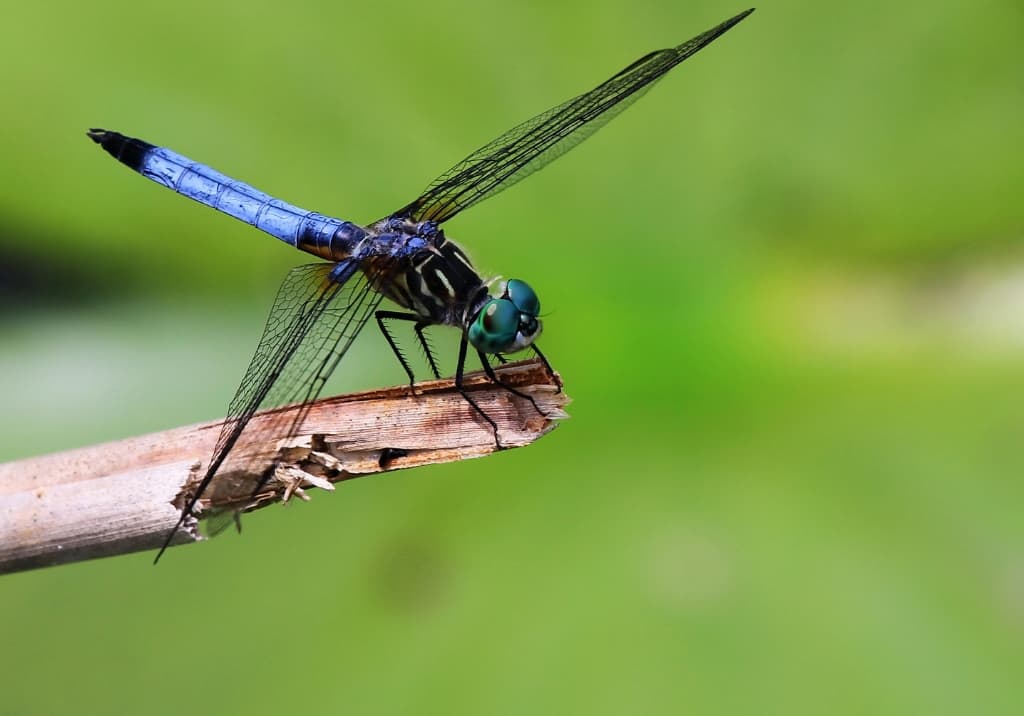
Blue is the most common color in dragonflies. It appears on the body, eyes, and wings of dragonflies. The blue dragonfly and the blue emperor dragonfly are two of the most popular species of this color.
Blue dragonflies are associated with wisdom, spiritual awareness, and mental clarity. The calming color of blue evokes a sense of peace and harmony, making the blue dragonfly a symbol of inner peace and spiritual enlightenment.
Moreover, the blue dragonfly has meanings of loyalty and trust.
In various spiritual beliefs, blue is connected to the ethereal realm and is seen as a messenger from the spiritual world.
If you see a blue dragonfly, it might suggest you slow down, find peace, or seek spiritual growth.
Furthermore, blue is linked to the fifth chakra – the throat chakra – which helps you communicate better with those around you.
Green Dragonfly Meaning
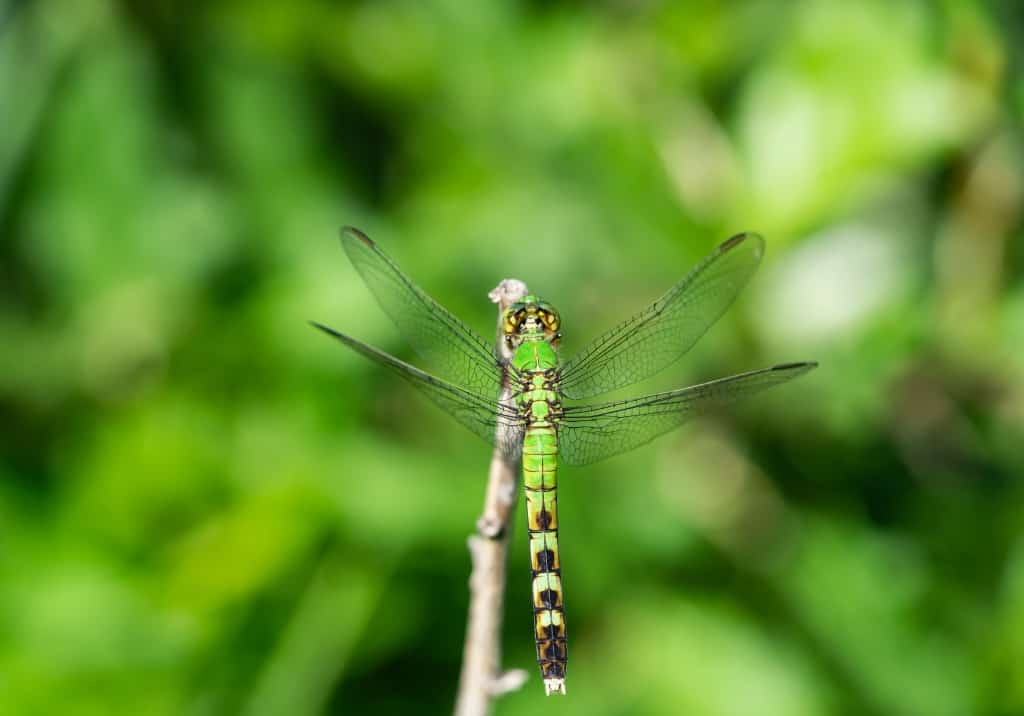
Green is an iridescent color in many dragonfly species, such as the Darner, Pondhawk, and Hawaiian giant dragonflies. The latter is the largest and fastest-growing green dragonfly species in the United States.
The green dragonfly symbolizes growth, renewal, balance, and harmony with nature.
Moreover, it’s a symbol of transformation and personal growth, encouraging you to embrace change and the opportunities for growth and renewal that come your way.
Seeing a green dragonfly could be a reminder of the need for personal growth or the importance of harmony in life.
Green is also related to the heart chakra, which is responsible for compassion, love, and forgiveness.
Red Dragonfly Meaning
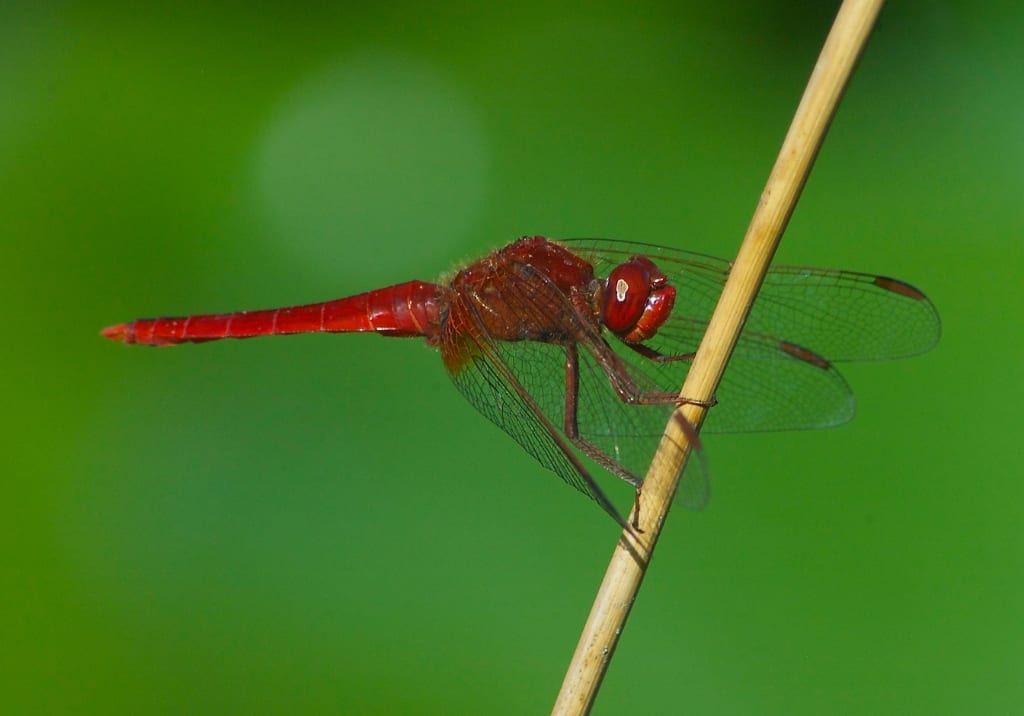
Red dragonflies, while less common than their blue and green counterparts, are a stunning spectacle due to their vibrant color. Although red dragonflies live on all continents, they are quite rare, making seeing one a unique experience.
Examples of red dragonflies include scarlet darter, red-veined darter, cherry-faced meadowhawk, ruby meadowhawk, and broad scarlet. Native species in North America are the cherry-faced meadowhawk and ruby meadowhawk.
Red dragonflies symbolize power, strength, and courage. Moreover, they can represent passion, love, and romance.
In many cultures, the color red is associated with energy and life force, making red dragonflies a symbol of vitality and resilience.
In addition, red dragonflies are often believed to bring good fortune and success, inspiring you to pursue your goals with unwavering determination.
When you see a red dragonfly, it could also represent a call to harness your inner strength or reconnect with your passions.
Furthermore, red is related to the first chakra – or the root chakra. This is linked to primal instincts: needs for survival and self-preservation. Moreover, it’s responsible for strength and vitality.
Yellow Dragonfly Meaning
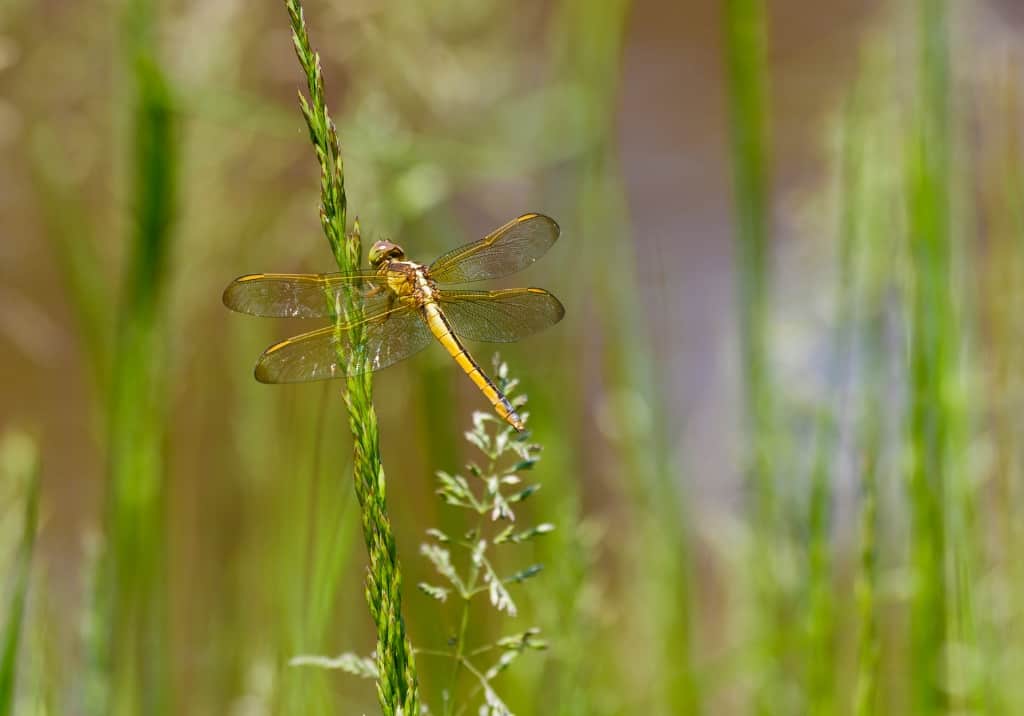
In some dragonfly species, juvenile males may exhibit a yellow coloration before transitioning into adult colors. These young males may showcase yellow or a combination of yellow and other colors.
Their yellow coloring can vary from pale, almost gold, to a vibrant, sunlit hue.
Yellow dragonflies are seen as symbols of joy, happiness, and optimism.
Yellow dragonflies signify joy, happiness, and energy. Moreover, they’re associated with optimism, creativity, and enlightenment.
Yellow dragonflies are often associated with the sun’s energy, symbolizing vitality, enlightenment, and awakening one’s spirit.
Seeing a yellow dragonfly might represent a reminder to maintain a positive outlook through hope and optimism.
Moreover, yellow is associated with the Solar Plexus chakra. This chakra is related to personal power, confidence, self-esteem, and transformation. So, it governs your ability to be confident and assertive.
Orange Dragonfly Meaning
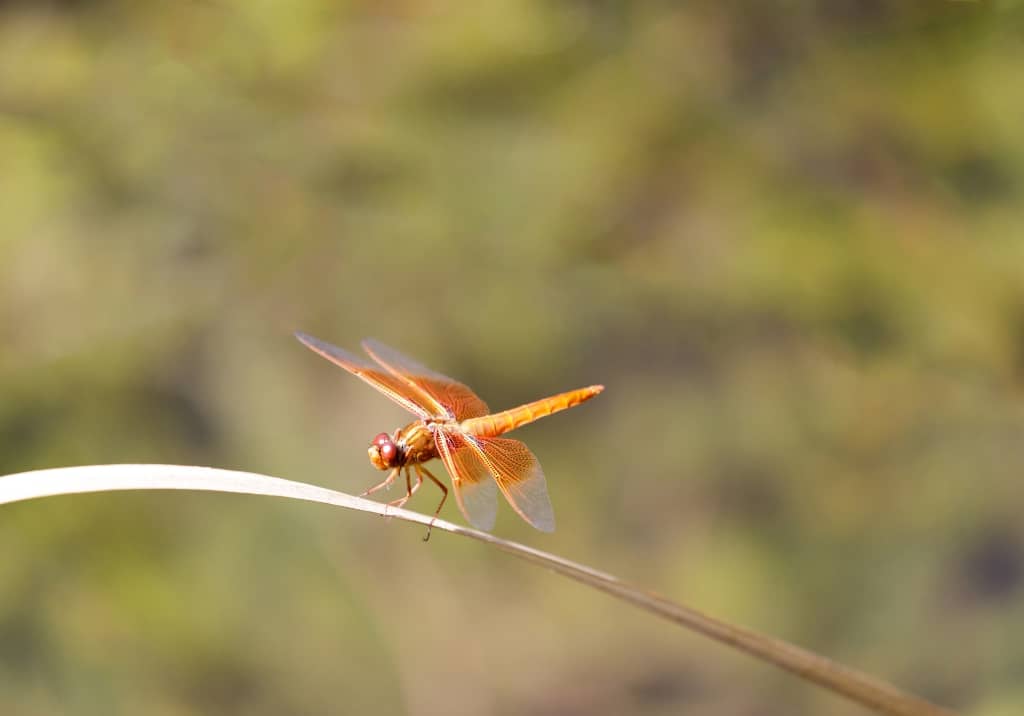
Like yellow, orange is a fairly uncommon dragonfly color. Some examples of orange dragonflies include the flame skimmer, firecracker skimmer, golden-winged skimmer, and orange meadowhawk.
Orange dragonflies symbolize enthusiasm, creativity, and joy. Also, this color is often associated with warmth, positive energy, and wellness. Moreover, they are a reminder to trust your gut instincts.
Orange is linked to the sacral chakra, which is responsible for your emotions, creativity, and sexuality. Thus, this energy center governs your ability to relate to others.
Thus, they are seen as symbols of creativity and inspiration, bringing a sense of joy, enthusiasm, and playfulness.
Seeing an orange dragonfly could indicate that you require more physical well-being to stimulate creativity and positive emotions.
Purple Dragonfly Meaning
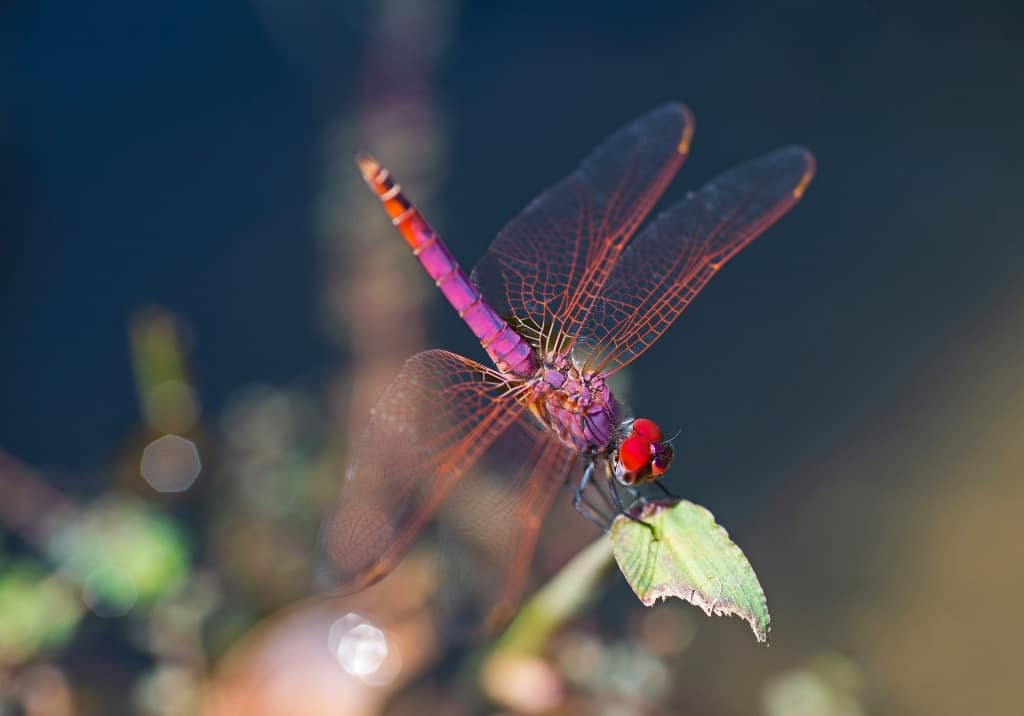
While dragonflies come in various colors, including blue, green, red, orange, or black, the color purple is not so common.
There are a few purple dragonflies, such as the Violet Dropwing (Trithemis annulata) found in southern Europe, Asia, and Africa, and the Purple Darter (Trithemis annulata) found in Africa. These dragonflies’ color is often described as reddish, pinkish, or violet.
Purple is a royal color that symbolizes wisdom, creativity, and spirituality.
Moreover, it is linked to the third eye chakra, also known as the crown chakra. This energy center is associated with spirituality, inner peace, and higher consciousness.
So, what a purple dragonfly means?
Purple dragonflies can represent wisdom and spiritual awareness.
If you see a purple dragonfly, it could be a sign to tap into your higher self through prayer or meditation. Furthermore, it is a symbol that can guide you to seek spiritual awakening.
Black Dragonfly Meaning
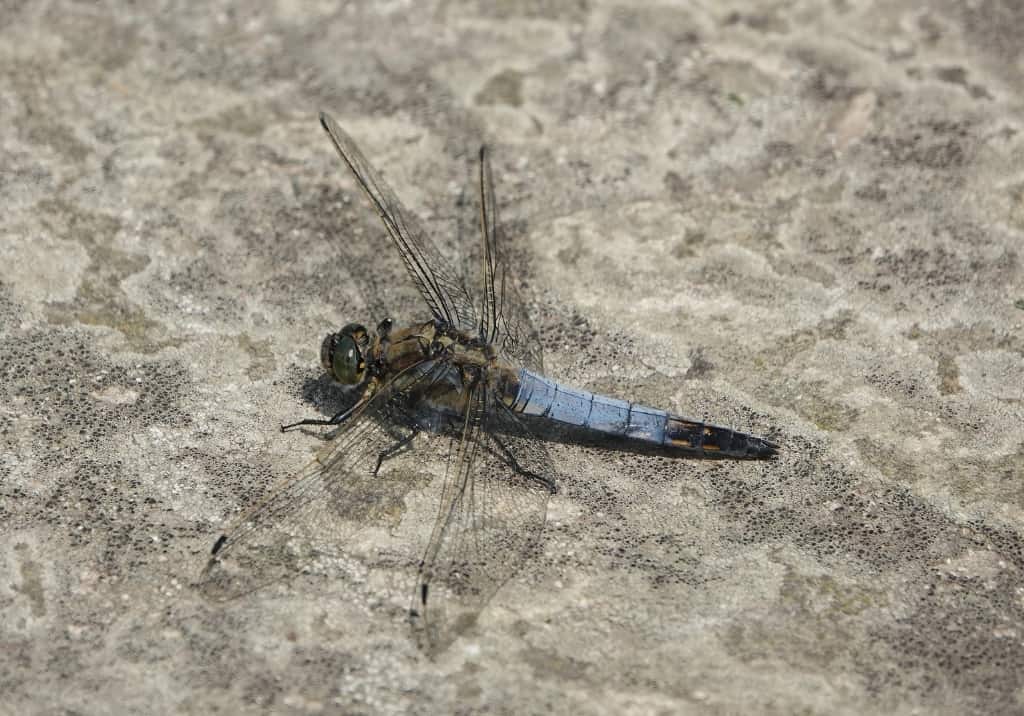
Black is the color of mystery, strength, and protection.
Black dragonflies are common, even if you’ve never seen one before. The most famous black dragonfly examples include black petaltail (North America), giant petaltail (Australia), black saddleback (New Zealand), black darter, and black-tailed skimmer (Europe and Asia).
In terms of symbolism, black dragonflies carry exciting meanings. That’s because black is linked to mystery, power, elegance, and transformation. It can also represent the darker side of life, the unknown, or signify a significant change.
Black dragonflies can symbolize change, self-realization, or the mystery of the unknown. Moreover, they could represent a symbol of personal transformation.
When you see a black dragonfly, it could be a sign of upcoming change or a prompt to explore the unknown depths of oneself.
White Dragonfly Meaning
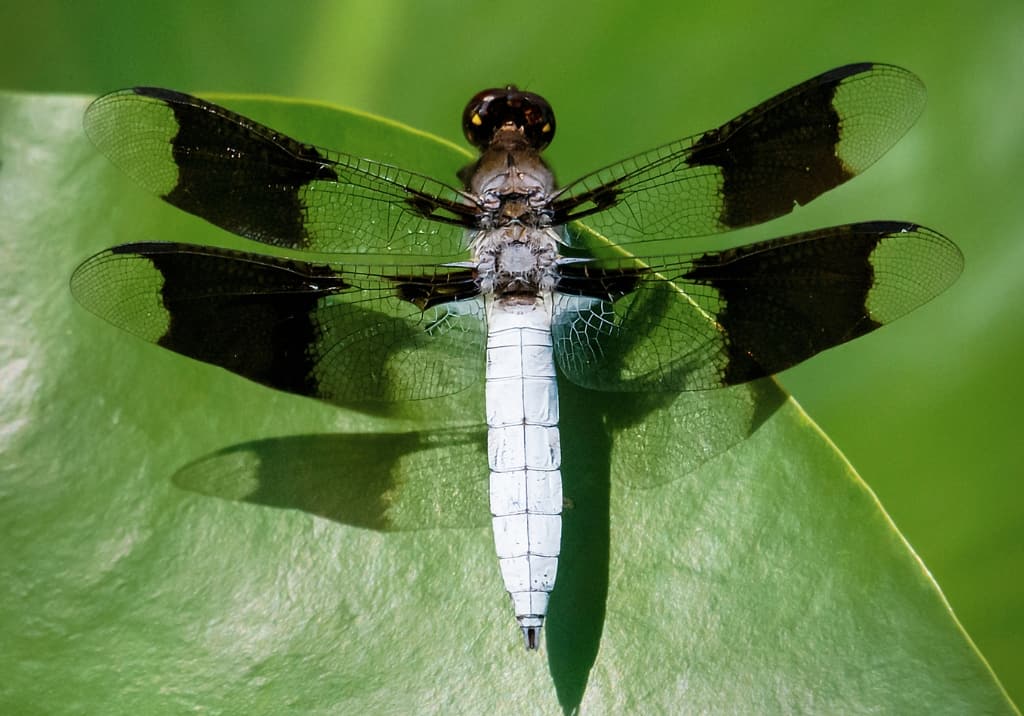
White dragonflies are relatively rare, making them quite unique. The color is actually a combination of white and other colors. Thus, white in these dragonflies is found on the tail or wings, in combination with brown or black.
White corporal and common whitetail are the most popular species of white dragonflies, both native to North America.
When it comes to meanings, white is a symbol of purity, innocence, light, goodness, and heaven. So, white dragonflies represent a little bit of each. In addition, white is linked to the crown chakra, which connects us to the divine and highest level of awareness.
When you see a white butterfly, it can represent spiritual growth and transformation. But it can also be a symbol of good luck and prosperity.
However, in some cultures, it is said that someone who passed away is trying to send you a message when you see a white dragonfly.
Brown Dragonfly Meaning
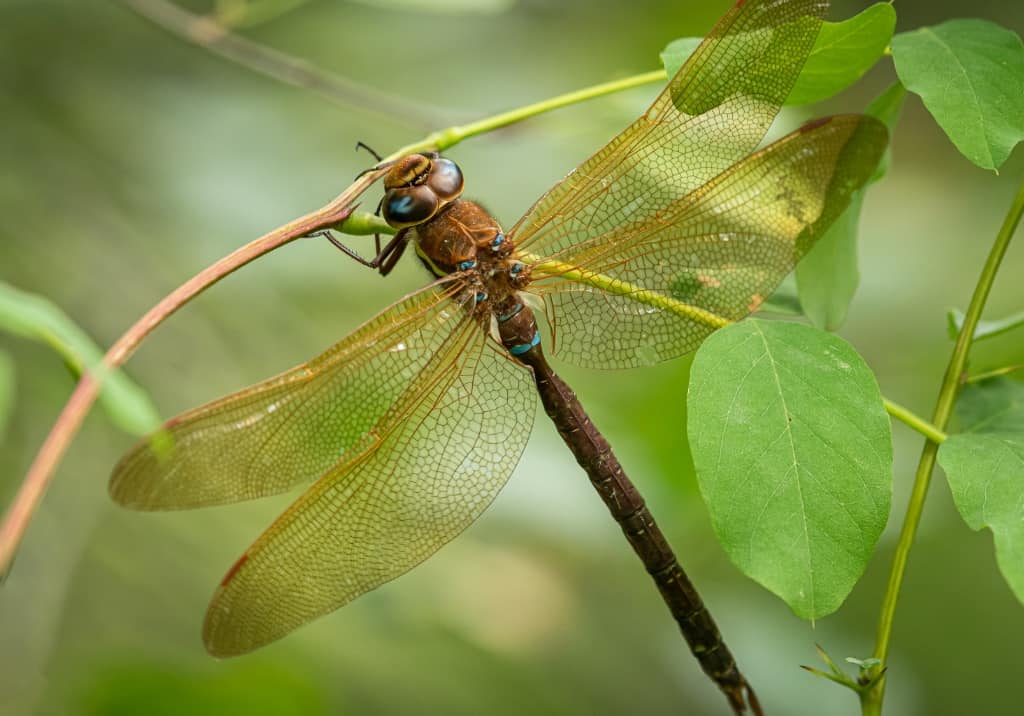
Brown is one of the most common butterfly colors. Their color allows them to blend into many natural environments.
Some examples of brown dragonflies include brown hawker, Norfolk hawker, stripe-winged baskettail, swamp darner, and common baskettail.
Brown is a symbol of stability, reliability, humility, and groundedness. Thus, the brown dragonfly symbolizes grounding in nature, the necessity of staying humble, and the importance of reliability and trustworthiness.
Seeing a brown dragonfly can be perceived as a reminder to keep your feet on the ground, even amidst rapid changes and transformations in life.
Gray Dragonfly Meaning
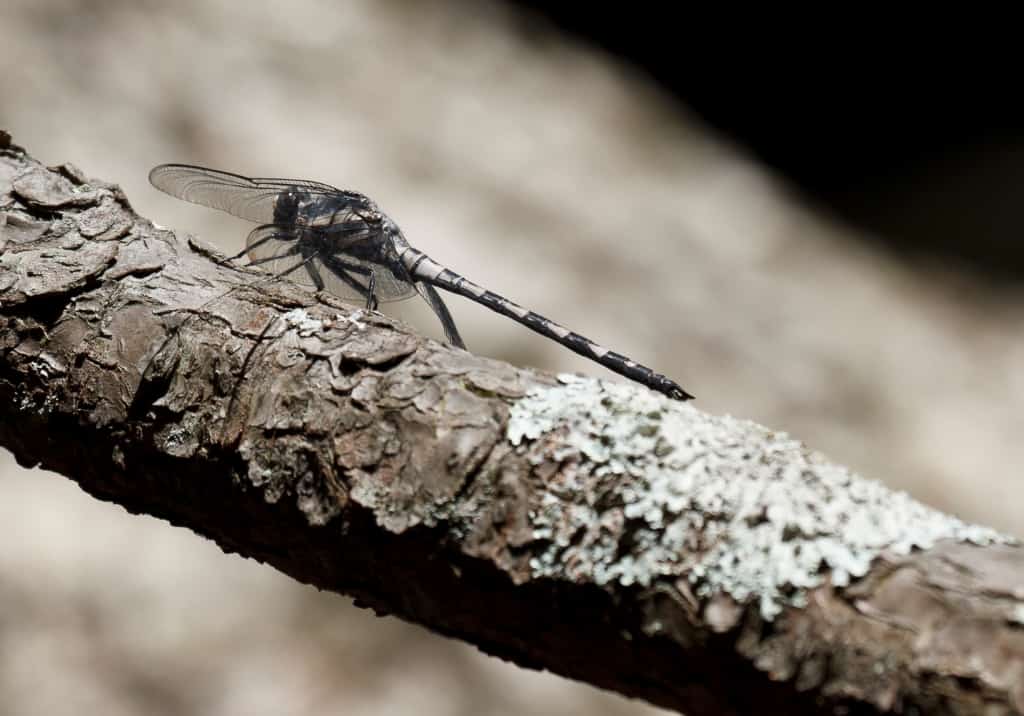
Although there are no 100% gray dragonflies, some species contain gray. As you have seen, most colors of dragonflies also help camouflage. In this case, the color grey helps them to camouflage very well on tree trunks.
The gray dragonflies include the gray sand dragon, gray petaltail, eight spotted skimmer, and filigree skimmer. This color provides them with excellent camouflage against rocks and tree bark.
But what does a grey dragonfly represent?
Gray is a symbol of neutrality and balance, as a mixture of black and white. It is often associated with wisdom and maturity.
If you see a grey dragonfly, it could mean that you need to find balance in your life. Or it may represent a need for clear-headedness.
Last Words on Dragonfly Colors Meanings
Each dragonfly color carries its own symbolism and interpretation, making the world of dragonflies rich and diverse.
So whenever you see a dragonfly, consider it a special moment. Remember its color to see what it means.
Did you enjoy this post on the colors of dragonflies? Share it with your friends interested in the color symbolism of these wonderful creatures.

